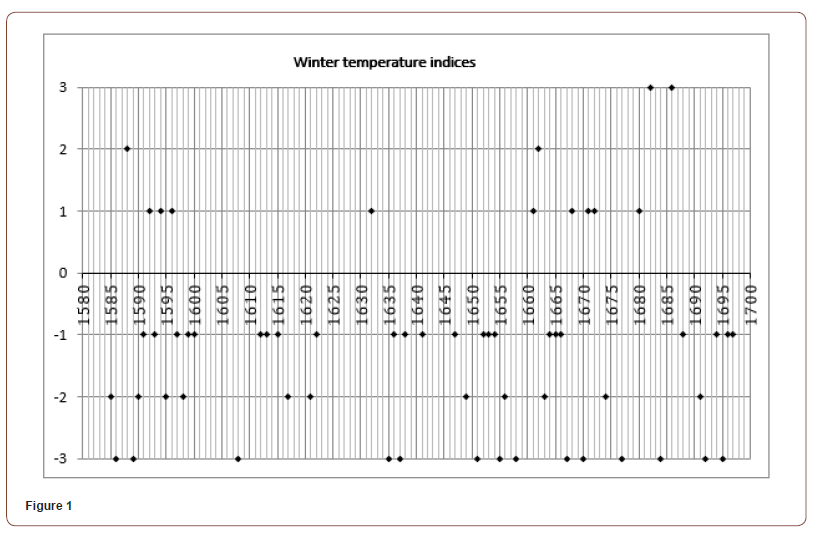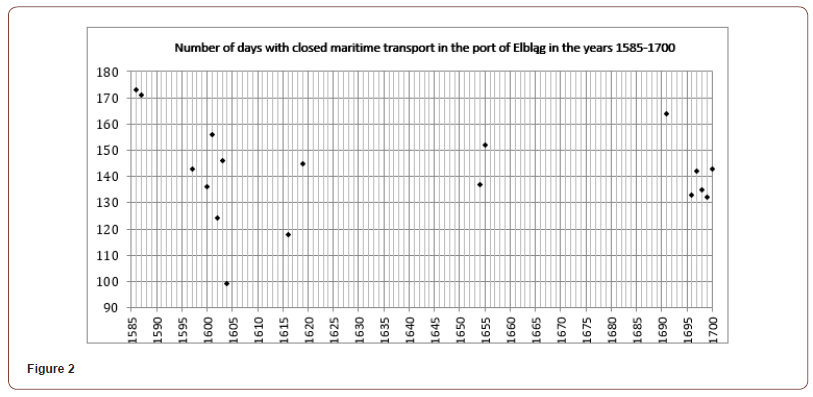 Mini Review
Mini Review
Severe Winters and Interruptions in Shipping Traffic in The Port of Elbląg in The Period 1585-1700
Piotr Olinski*
Department of Medieval History, Faculty of History, Nicolaus Copernicus University Torun, Poland
Piotr Olinski, Department of Medieval History, Faculty of History, Nicolaus Copernicus University Torun, W. Bojarski 1 Street, Torun, Poland.
Received Date: July 21, 2021; Published Date: August 10, 2021
Abstract
The reconstruction of weather conditions during winters in Pomerania by the Baltic Sea in the period from 1585 to 1700 was carried out based on narrative historical sources. During this 115-year period, 26 extremely severe and severe winters were distinguished. The results of this reconstruction were compared with the length of maritime transport inactivity in the port of Elblag during these winters. Due to incomplete sources, this was only possible for selected years. It turns out that winters graded as severe and extremely severe coincide with a transport breakdown in the port of Elblag for a period of 152 to 173 days, while winters rated as moderately severe – for a period of 133 to 143 days.
Keywords: Climate in the past; Pomerania; The Baltic Sea; Maritime transport
Introduction
Climate reconstructions for historical times are based on documentary and natural proxy data [1,2]. There are several reconstructions which have been undertaken in relation to Polish lands [3-6], however, if individual Polish regions are considered, their number is much less. Most of the reconstructions were conducted for Silesia [7]. As far as the areas directly located on the southern coast of the Baltic Sea are concerned, such reconstructions were carried out for Mecklenburg (ice in the Western Baltic) [8]. This article presents a reconstruction of winter seasons in Pomerania. At the same time, it focuses on the shutdown of maritime transport on the Baltic Sea in winter seasons, knowledge which can be garnered from Pfundzoll (pound customs duty) records of the port of Elbląg [9].
Materials and Methods
In the case of old Polish lands, measurements of such parameters as temperature, precipitation and pressure taken regarding longer periods began in the 18th century [10]. To refer to earlier periods, historical written sources that describe weather and climate need to be referred to. For an evaluation of these records, a scheme has been developed, which usually uses a 7-grade scale (for winters: -3: extremely cold; -2: severe, -1: fairly cold, 0: average; 1: moderately warm, 2: warm, 3: very warm). For some regions, written sources that give other parameters are also used. Such sources may include logs with dates of the arrival of ships to the Baltic ports. It is assumed that the arrival of the first ships in spring meant the disappearance of ice floes on the Baltic Sea, which in the winter season made transport impossible. The departure of the last ships from harbours in autumn or early winter meant the closure of transport on the Baltic due to ice. This was the basis for the reconstructions of winter conditions for such ports as Tallinn (11), Riga (12). This paper will reconstruct severe winters on the southern coast of the Baltic Sea in Pomerania based on written sources. The extremely severe winter grade (-3) is given to those winters when the freezing of the Gulf of Gdansk made it possible to travel on the ice between Gdansk and Hel; those described as exceptionally severe which lasted for a considerable peri of time and finally also to those described as such by witnesses who referred to them as extreme in comparison to their recollections of previous such occurrences. The severe winter grade (-2) was given to those winters which also afforded people the opportunity of traversing the ice on the Baltic Sea, but for a shorter period and to those when strong frosts were noted, but without the uniqueness of such an occurrence being highlighted. The cold winter grade (-1) was used to evaluate cold weather which was not considered severe or difficult. Despite all attempts to adopt objective criteria, the evaluation of information from written sources will always be subject to the risk of error.
The results of such reconstructions will be compared with the periods of winter shipping closures based on the dates of the arrival of the first and the departure of the last ships into the port of Elblag. Pfundzoll duty registers have survived for this port in relation to 34 years from the 1585 to 1700 period [9], (missing registers refer to the years 1588-1593, 1595, 1598, 1606, 1608-1611, 1613-1614, 1617, 1621-1622, 1624, 1626-1652, 1656-1684, 1686, 1688-1689, 1692-1694). Despite this relatively modest number of registers, they offer researchers the possibility of comparing them with the results of winter season reconstructions carried out on the basis of narrative written sources, such as chronicles, yearbooks, diaries, correspondence, and a variety of other documents.
Results and Discussion
Winters with a -3 grade, i.e., extremely severe, were recorded for 1585/86, 1588/89, 1607/08, 1634/35, 1636/37, 1650/51, 1654/55, 1657/58, 1669/1670, 1676/1677, 1681/82, 1683/84, 1691/92, 1694/95, severe winters, on the other hand, took place in 1584/85, 1589/90, 1594/95, 1597/98, 1598/99, 1616/17, 1620/21, 1648/49, 1655/56, 1662/63, 1673/74, 1690/91 [Figure1].

It is possible to show the number of days for which shipping traffic in the port of Elblag was closed only for some years - in 1585/86 (-3) for 173 days, in 1654/55 (-3) for 152 days, 1690/91 (-2) for 164 days. Thus, it could be assumed that extremely severe and severe winters resulted in the suspension of shipping for a period of 152 to 173 days, or about 5 months or more. As far as winters rated as moderately severe (-1) are concerned, based on narrative sources, the periods of navigation closures in Elblag were somewhat shorter, ranging from 133 to 143 days. In the winter of 1596/97 (-1) ships did not operate for 143 days, 1599/1600 (-1) for 136 days, 1653/54 - for 137 days, in the winter of 1695/96 – for 133 days, in the winter of 1696/97 - for142 days [Figure2].
Conclusion
It seems, therefore, that from a methodological perspective it is good to carry out separate reconstructions of climate in historical times on the basis of homogeneous types of historical sources, and then to compare the obtained results. This allows the reliability of the data contained in each group of historical sources to be assessed.

Acknowledgement
This research was supported by a grant entitled “The occurrence of extreme weather, climate and water events in Poland from the 11th to 18th centuries in the light of multiproxy data”, funded by the National Science Centre, Poland (grant no. 2020/37/B/ ST10/00710).
Conflict of Interest
No conflict of interest.
References
- Pfister Ch (1999) Wetternachhersage: 500 Jahre Klimavariationen und Naturkatastrophen. Bern, pp. 304.
- Glaser R (2008) Klimageschichte Mitteleuropas. 1200 Jahre Wetter, Klima, Katastrophen, Primus Verlag, Darmstadt, pp. 264.
- Polaczkówna M (1925) Climatic variations in Poland during the middle ages, Książnica Atlas, Lwów, pp. 80.
- Sadowski M (1991) Variability of extreme climatic events in Central Europe since the 13th century. Zeitschrift für Meteorologie 41: 350-356.
- Przybylak R, et al (2005) Temperature changes in Poland from the 16th to the 20th centuries, International Journal of Climatology 25: 773-791.
- Luterbacher J (2010) Climate Change in Poland in the Past Centuries and its Relationship to European Climate: Evidence from Reconstructions and Coupled Climate Models In: Przybylak R, Majorowicz J, Brázdil R, Kejna M, The Polish climate in the European context, an historical overview, Springer, Dordrecht, pp. 3-39.
- Inglot S (1966) Badanie zjawisk klimatyczno-meteorologicznych na Śląsku od XVI do połowy XIX w. Studia z Dziejów Gospodarstwa Wiejskiego 8: 69-71.
- Koslowski G, Glaser R (1995) Reconstruction of the ice winter severity since 1701 in the Western Baltic, Climatic Change 31: 79-98.
- Lindblad J Th (1995) Dutch entries in pound-toll registers of Elbing 1585-1700, Instituut voor Nederlandse Geschiedenis, Den Haag, pp. 499.
- Przybylak R (2010) Instrumental Observations In: Przybylak R, Majorowicz J, Brázdil R, Kejna M, The Polish climate in the European context, an historical overview, Springer, Dordrecht, pp. 129-166.
- Tarand A, Jaagus J, Kallis A (2013) Eesti kliima minevikus ja tänapäeval, Tartu Ülikool Kirjastus, pp. 632.
- Jevrejeva S (2001) Severity of winter seasons in the northern Baltic Sea between 1529 and 1990: reconstruction and analysis, Climate Research 17: 55-62.
-
Piotr Olinski. Severe Winters and Interruptions in Shipping Traffic in The Port of Elbląg in The Period 1585-1700. World J Agri & Soil Sci. 7(3): 2021. WJASS.MS.ID.000664.
-
Climate in the past, Pomerania, the Baltic Sea, Maritime transport
-

This work is licensed under a Creative Commons Attribution-NonCommercial 4.0 International License.






